mechaware——PT and PVT Path Motion
来源:互联网 发布:wps如何描述型数据 编辑:程序博客网 时间:2024/06/03 04:35
PT and PVT Path Motion PT和PVT路径运动
Introduction
This document describes the position-time (PT) and position-velocity-time (PVT) path interpolation algorithms for the XMP controller. A technical description of each algorithm pointing out the advantages and disadvantages is contained in the following sections of this document.
本文介绍位置-时间(PT)和位置-速度-时间(PVT)路径插值算法。下面包含了两种算法的优缺点。
General Characteristics
PT and PVT algorithms convert a series of point-time pairs into XMP motion frames that create the real-time command positions at each sample during the time intervals between the point-time pairs. The PVT interpolation type requires additional data at each point (the vector velocity). A “point” in these point-time series may have several dimensions (axes).
PT和PVT算法将一系列的点-时间对写入到控制卡中,在每个采样创建一个实时的位置。PVT插值类型需要每个点上的附加的数据(速度)。一个点可以有对个维度(多轴)。
PT Algorithm
The PT algorithm fits a simple constant velocity profile between the user specified “Position and Time” points. The PT algorithm guarantees that the XMP’s trajectory calculator will exactly hit each specified position at the specified time. The constant velocity segment is simply calculated by the difference of the positions divided by the time interval:
在用户定义的“位置和事件”点之间,PT算法计算出一个合适的速度曲线。PT算法保证控制卡的轨迹计算符合每一个已知的点和时间。分段速度简单的由位置和时间的差分计算出来。
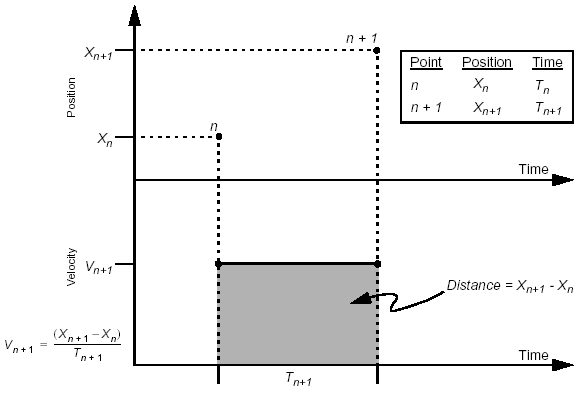
PT algorithm
Simple PT Example
For example, a trapezoidal velocity profile motion could be generated using a list of Position and Time points:
例如,一个梯形速度运动可以由一系列的位置和时间点构成:
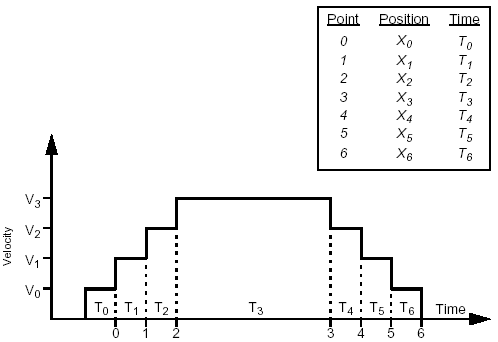
PT profile (trapezoidal)
When is the PT algorithm useful?什么时候用PT算法?
The PT algorithm is very good for closely spaced points or low velocities. It is a very simple algorithm, requiring very few calculations; therefore, it is fast. It works well with low performance motion systems. If the points are spaced too far apart, the motion will be rough, because the acceleration between each point is instantaneous. It is best to keep the point spacing within a few samples. The XMP-Series default sample rate is 500 microseconds.
PT算法对于近距离的点运动或者低速运动很合适。每个点之间的加速度是瞬时的。最好保证点的跨距在几个采样。
PVT Algorithm
The PVT algorithm fits a Jerk (non-constant acceleration) profile between user specified "Position, Velocity, and Time" points. The PVT algorithm guarantees that the XMP's trajectory calculator will exactly hit each specified position, with each specified velocity, at the specified time.
在用户定义的“位置、速度、时间”点之间,PVT算法计算出合适的Jerk参数。这个算法保证轨迹计算符合每个已知点的位置速度和时间。
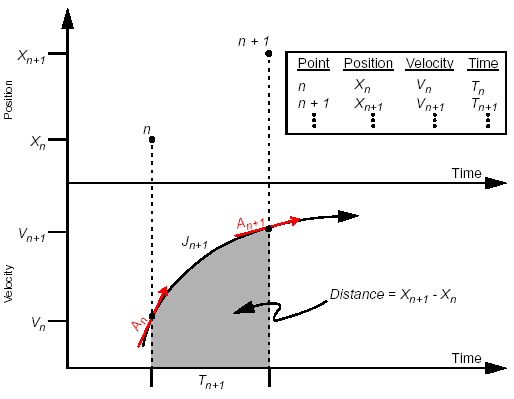
PVT algorithm
For each point, the PVT algorithm calculates the Acceleration and Jerk values to exactly hit the specified Position and Velocity at the next point. The equations for An and Jn, are derived from the standard kinematic equations:
对每一个点,PVT算法计算加速度和Jerk值,使得达到下一个点的特定位置和速度。An 和 Jn公式是由标准的动力学方程推导出来的。

The derivation of the kinematic equations in terms of An and Jn is beyond the scope of this document.
Simple PVT Example
For example, a trapezoidal velocity profile motion could be generated using a list of three Position, Velocity, and Time points:
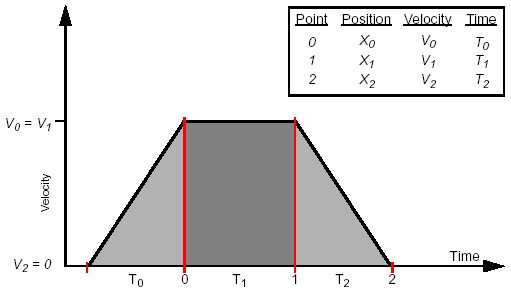
PVT profile (trapezoidal)
How do you calculate the Velocities for PVT paths? There are several methods to calculate the velocities, depending on the desired path profile. Here are some common methods:
- Calculate the change in distance between two points divided by the time:

This is a simple method, with relatively smooth performance. You will need to add an extra final point to the list, setting the last velocity to zero. - Calculate a constant acceleration fit between points. From the kinematic equations (with Jerk = 0), we know:

substitute (b) into (a), and solve for Vn+1
There are several other methods that can be used to calculate the velocities. Additionally, there are many other algorithms, like averaging and splines that can be
applied to PVT.
What happens if the Velocities are calculated improperly for PVT paths?
The PVT algorithm doesn’t care if the Position, Velocity, Time points are matched properly. The PVT algorithm will simply calculate a Jerk profile between points to reach the specified point. The profile between the points may not be desired, but it will be accurate.
For example, consider the simple three point trapezoidal profile from the PVT profile (trapezoidal) graph above. If the velocities at points 0 and 1 were too small, the profile would stretch to cover the proper distance (area under the curve):
如果自己规划的点的位置速度不合适:
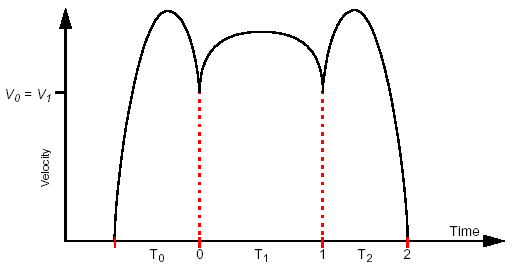
PVT profile, velocities too low
If the velocities at points 0 and 1 were too big, the profile would shrink to cover the proper distance (area under the curve):
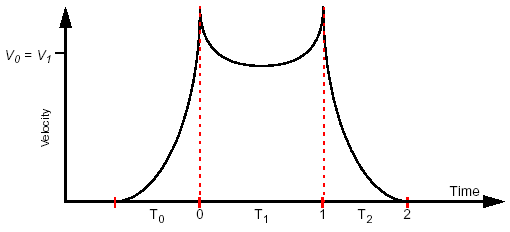
PVT profile, velocities too high
When is the PVT algorithm useful?
The PVT algorithm is very good for smooth and close path control. The points can be spaced very close or very far apart. For complex paths (or path portions) the points should be spaced close together. For simple paths (or path portions) the points can be spaced far apart. PVT can handle virtually any list of points. The most difficult part is determining the appropriate velocities at each point.
Test Cases
Three types of point-time series (step, zigzag, and octagon) were used to evaluate the paths created by the PT/PVT algorithms. Most higher order (polynomial) interpolation algorithms are better suited for describing continuously curved sections of paths than sections with straight lines and sharp corners. The step and zigzag path tests determine how well an algorithm behaves when the path was not very appropriate for high-order polynomials. The octagon path tests how well the algorithms interpolate circular sections of a path given a small number (8) of points around the circle.
The simplest path studied was a one-dimensional step. The following point-time series was used to test the interpolation:
(samples)
(counts)
(PVT only)
The step is useful for determining if the algorithm is going to have problems in sections of a path with sharp corners. The amount of overshoot (if any), the closeness to lines joining the points, and accelerations and velocities near the step can be evaluated. The step is also useful for determining how much of the path will be affected by a sharp corner (at what distance from the step does the path return to a straight line). For example steps affect Cubic spline interpolation over the entire path, where PT interpolation is only affected at the two points closest to the step.
The zigzag path (really a reversed “Z”) was used to evaluate sharp corner behavior in a two-dimensional (X-Y) path. The following point list formed the zigzag path:
(samples)
(counts)
(counts/sec.,PVT only)
The octagon path determines how well the interpolation algorithms are suited for circular sections of a path. The nine points along the path are on a circle with a radius of 5000 counts, centered at 0,5000. The first and last points are the same (at 0,0 the 6 o’clock position) and the points are spaced at angles of 45 degrees.
PT Interpolation
This is the simplest form of interpolation. The interpolation is linear (first order). While the path is mathematically continuous, velocity, acceleration, and jerk are not. The lines between points are straight and are traversed at constant speed. PT motion will usually be rough unless the points are very closely spaced in time or the velocities are very low.
Step behavior
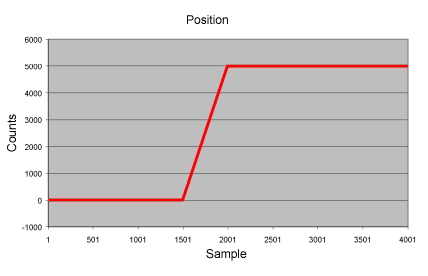
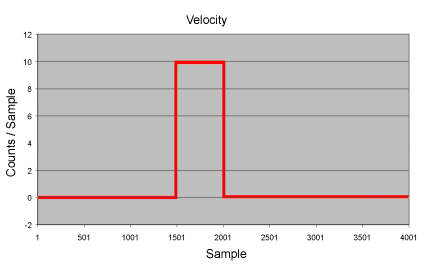
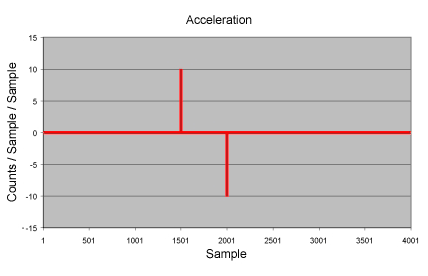
PT motion is well suited for paths composed of straight lines and sharp corners. The only serious problem with PT motion is the large number of points required to limit the peak accelerations. In this example the peak acceleration was 40 million c/sec/ sec.
Zigzag path behavior
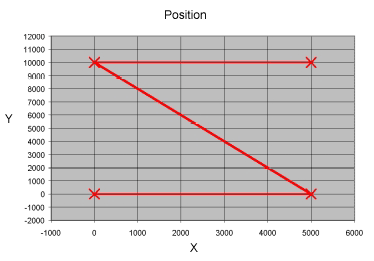
The path is simply straight lines joining the points.
Octagon path
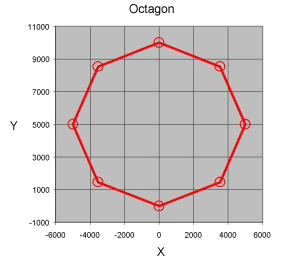
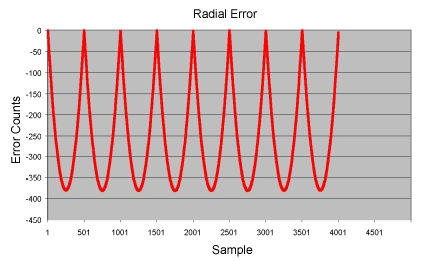
Again, the path consists of simple straight lines. Radial error is the difference between he distance from the interpolated path to the center from the radius of a circle through the points. The largest error is midway between the points.
PVT Interpolation
PVT paths are third order (cubic) rather than first order (ex: PT paths). The position and velocity are continuous, the acceleration and jerk are not. PVT paths tend to be much smoother than PT paths, but the velocity of each axis needs to be provided at each of the supplied points. This can increase the complexity of the application since the velocity at each point is often difficult to determine.
Step behavior
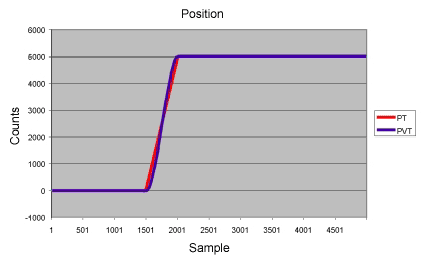
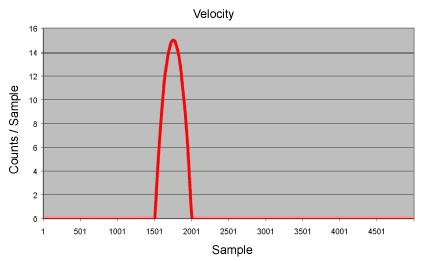
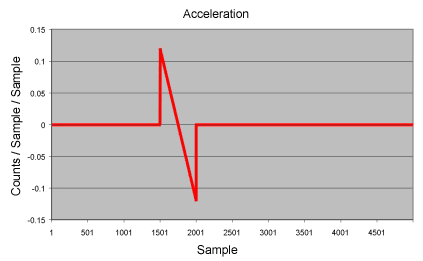
Zigzag behavior
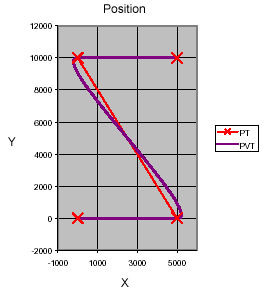
Octagon behavior:
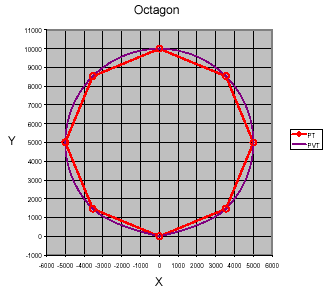
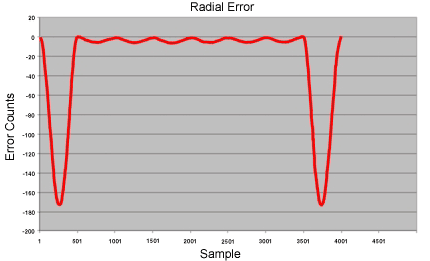
The larger error in the first and last segments is caused by the V=0 constraints at
the end points.
- mechaware——PT and PVT Path Motion
- mechaware——理解事件确认
- CSS3 motion-path 路径动画
- Tesseract OCR to Page (TPT) and Page Viewer (PVT)
- Fire and Motion
- CVPR2016 Motion and Tracking
- POJ1753——Robot Motion
- Fire And Motion(英文原版) [转]
- CALCULATE GLOBAL MOTION AND SMOOTHNESS
- Motion Classification and Target Tracking
- Motion-based Segmentation and RecognitionDataset
- Rigid Motion and Homogeneous Transformation
- hdu 1035——Robot Motion
- POJ(模拟)——Robot Motion
- 杭电ACM1035——Robot Motion
- poj1573——Robot Motion(模拟)
- 三维重建——Structure from motion
- 杭电ACM—HDU1035 Robot Motion
- js实现拖拽缩放
- jsp
- 《高级软件工程》学习总结与感想
- Java实现-数字组合2
- Executors
- mechaware——PT and PVT Path Motion
- Spring中Aspect注解使用
- 设计模式--命令模式
- 学习Linux命令(31)
- PAT 1036
- Java泛型小记
- Scala基础—函数式编程高阶示例,闭包、Currying等
- Linux for Ubuntu Intellij Idea 免費激活
- 最长公共子序列,最长上升公共子序列


